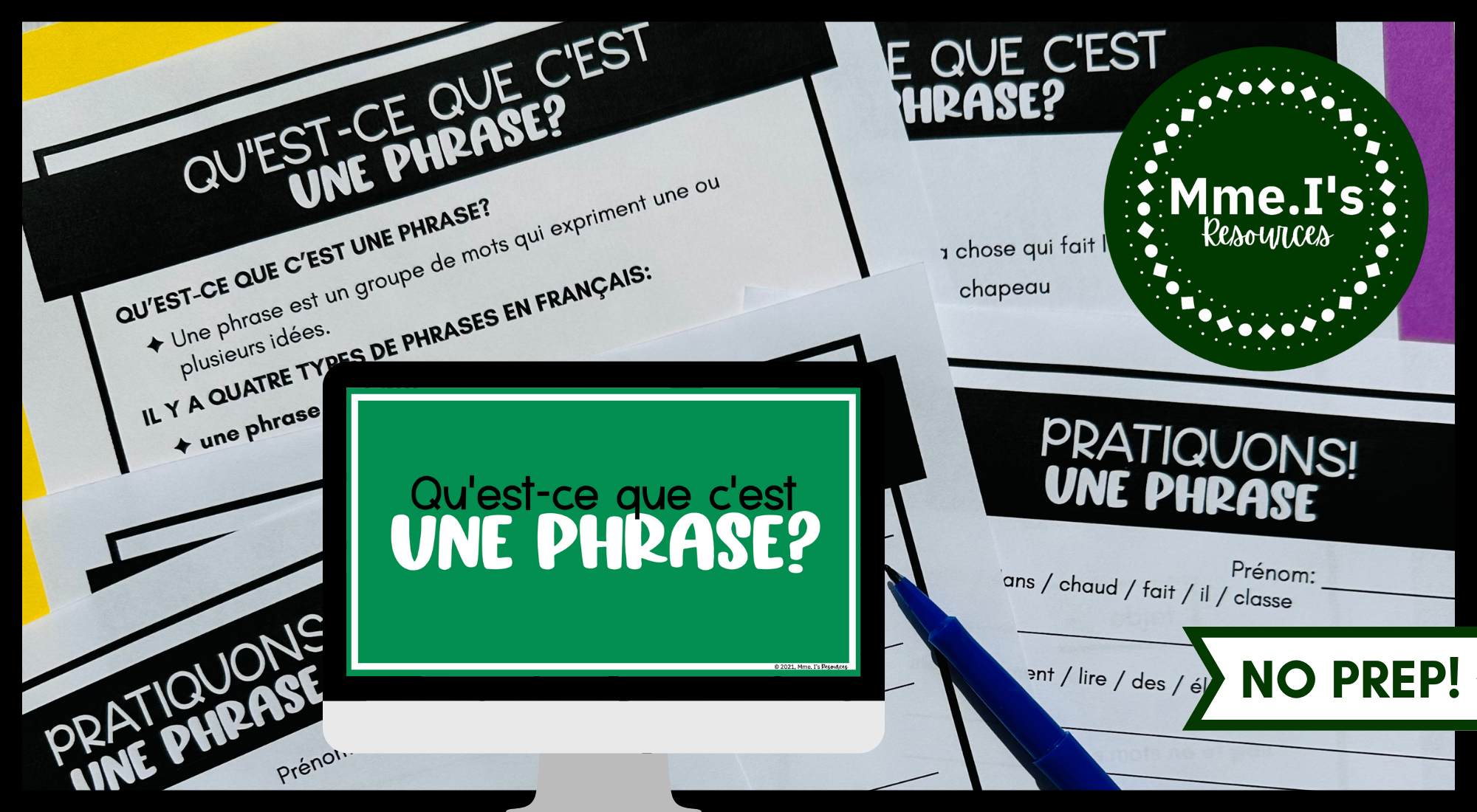If you’re a Core French teacher, there are certain questions you hear on repeat, almost every day:
- Can I use Google Translate?
- How do you say _______ in French?
- How do I write _______ ?
Even when you have directed your students away from Google Translate, there are almost always some who turn to it anyway. I mean, all you have to do is enter your text and you get a translation and voila, your work is done! It makes French so much easier! Right?
But of course, we as teachers know that Google Translate (or any other such translation device) is not the solution. And with AI now, things get even more challenging!
So, the question becomes, how do we get our students to write in French on their own? How do we give them the tools and the skills which they need to produce written French on their own? How do we stop them from being tempted to go to Google Translate?
Keeping all of these questions in mind, in this blog post I’ll share how I recommend teaching writing in a Core French classroom, what I think works best for me and my students, and some strategies I believe will be helpful to you in your classroom, as well.
Let’s get started.
What’s the struggle?
If I were to give you a topic in English and say write a paragraph about it, it would be fairly easy, right? You brainstorm your ideas and you draft your paragraph.
Now what if I told you to write it in Polish? You’d probably do something similar as above. And then, you’d use an English-Polish dictionary, maybe? You’d look up one word at a time and begin drafting the Polish translation of your paragraph, right?
That is almost always what our students do. They come up with their sentences in English (whether on paper or just in their mind) and then they grab a dictionary and look for the French words needed to express themselves in French. And while this makes sense and seems like a good way forward, it almost always is not. Here’s why.
When students use this method to write in French, they are simply translating their ideas, word-for-word. They are not taking the time to think about the grammatical structures or vocabulary which they have learned in French and come up with their own writing. They are thinking about what they want to say, all the while knowing that they can use an English-French dictionary to help them find all the words they do not know (and there are inevitably a lot of them!).
As a result, every time they are given a writing task, the cycle repeats itself.
So let’s look at what I would recommend, instead.
How I Teach Writing in my Core French Class
At the beginning of the year, usually in late September or early October, I teach my students a formula for writing. I know what you must be thinking, formulas in French class? My students often groan when they hear me say it, too. But, they’re actually my favourite and I use them for many of the concepts I teach in French! Hear me out.
Before I teach my students about the formula, we talk about what a sentence is, the different kinds of sentences (for example une phrase déclarative), and the three parts of a sentence (sujet, verbe, objet).
Once my students grasp these foundational basics, they are ready for the formula:
sujet + verbe (conjugué) + objet
At this point, my students understand what each of these three parts are, they can come up with a series of examples for each of these parts and they are now ready to plug in the pieces to make their own sentences.
While the students are able to do this most of the time, sometimes a few of them will revert back to the old method: direct word-for-word translation. I can’t quite blame them. They have this great idea in their head, but it is in English. They just want to write it down in French. In such a case, we have to ensure that we have provided enough scaffolding for our students and then encourage them to come up with ideas in French using the vocabulary they have learned and the ideas they can communicate on their own without relying on dictionaries. Yes, occasionally, they may need to go ahead and look up a word or two, however, an English-French dictionary isn’t their best friend in my French class.
Using this formula, while their sentences won’t be long and fancy, they are something my students can produce on their own. Not only do they make me, the teacher, proud, but the students always feel a sense of accomplishment as well!
Let’s look at an example:
So, with Spring around the corner here in Ontario, let’s say we are currently learning about Spring vocabulary in French class. Once I have introduced the vocabulary (a combination of nouns and verbs), I will give my students multiple (multiple!) opportunities to play around with that vocabulary so that they can retain it. Once they’ve got it, they’re ready to use their vocabulary and plug it into the formula. So, without the use of a dictionary, a student might come up with simple sentences such as:
- Maman arrose les plantes.
- Je joue dehors.
- Emma regarde le papillon.
- Les fleurs poussent dans le jardin.
Over time, as my students are exposed to more and more vocabulary, and as they practise their writing more and more, they are able to come up with longer and more complex sentences that involve the use of things such as adjectives, adverbs, negation and prepositions.
Here’s what you need:
After much trial and error, and after many adjustments, I can confidently say that I have now carefully crafted the perfect lesson to teach my students this method of writing in French.
Once students begin to understand this method, it is so amazing to see their eyes sparkle with joy when they are able to write sentences on their own!
Want to give my method a try and not have to recreate everything yourself?
Check out one of my best-selling resources for teaching writing to your students! It works well with both Core and early-writer Immersion students, it contains everything you need, is both digital and printable and requires 0 prep!
Here is what one teacher had to say about it:
☆☆☆☆☆
“This was a great tool to introduce my MFI students to writing in French. It was really helpful and made teaching sentences much easier!
— Serena S.”
Click the image below to check it out!
A few final tips
Lastly, here are a few additional points you should also consider when teaching your students how to write in French:
- Foster a supportive writing environment where students feel comfortable taking risks and making mistakes in their writing.
- Provide multiple opportunities for students to practise writing.
- Incorporate authentic writing tasks about topics that are relevant and meaningful to students.
- Model writing strategies such as brainstorming, planning, drafting, revising, and editing.
- Provide regular and continuous feedback.



